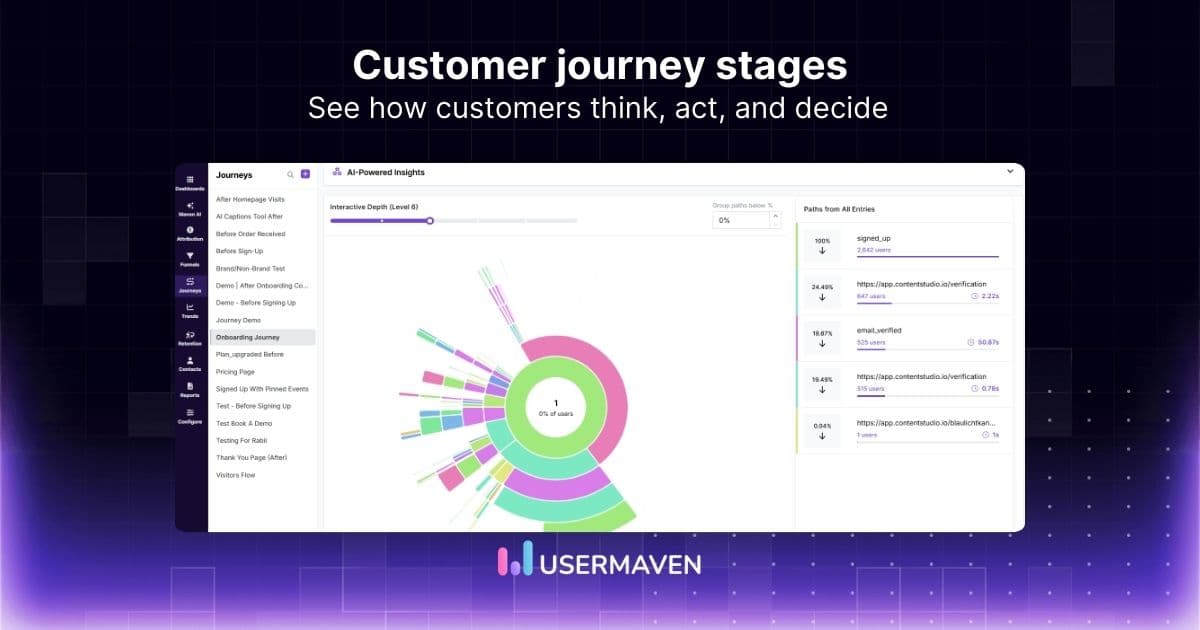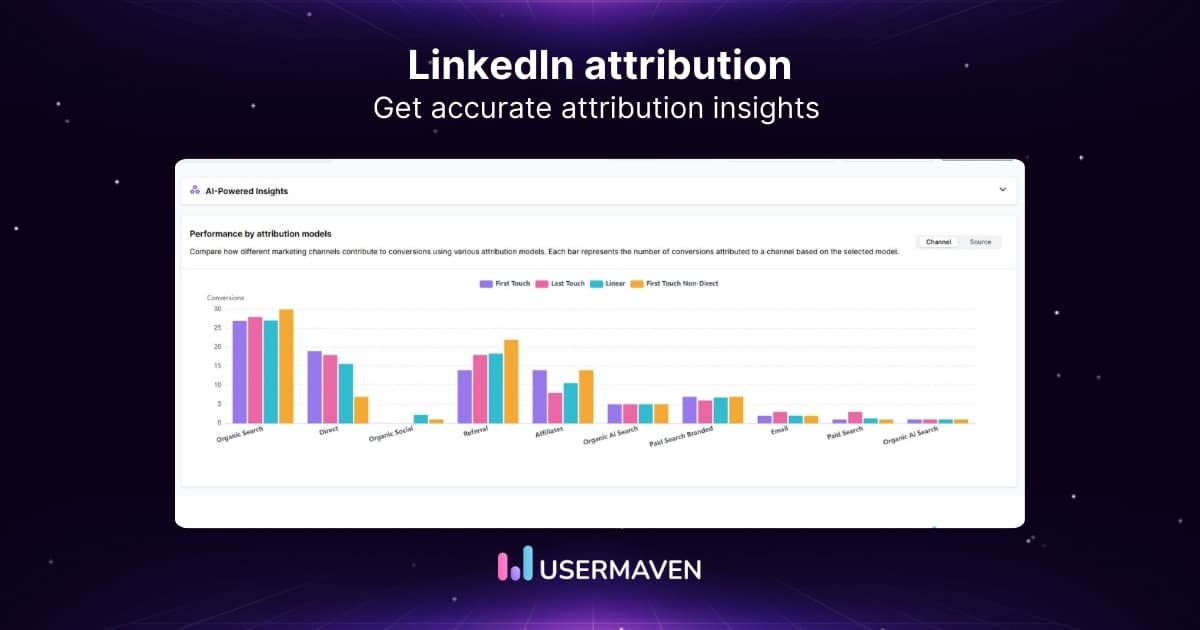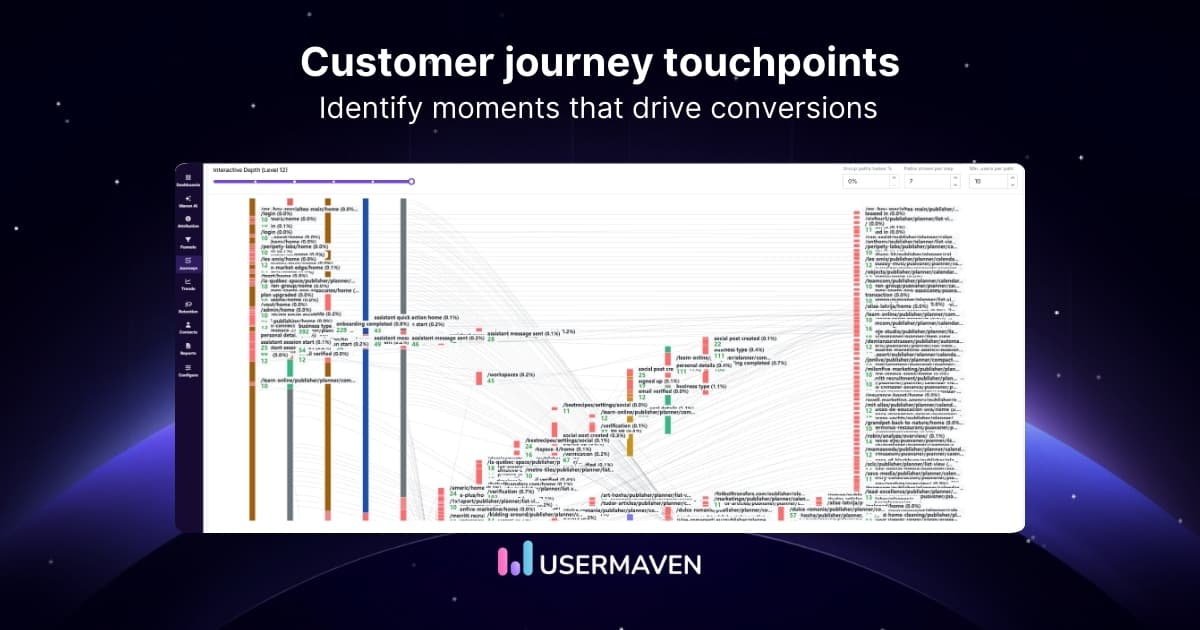Table of contents
Building a successful product analytics strategy: A step-by-step guide
Jan 17, 2025
7 mins read
Written by Ameena Hassan

Crafting a winning product analytics strategy isn’t just about crunching numbers; it’s about turning data into actionable insights that drive success. In today’s competitive landscape, understanding user behavior and product performance is essential for growth. Whether you’re refining features, improving retention, or aligning your product with customer needs, a well-thought-out strategy helps you make smarter decisions.
This blog dives into the key elements of building and implementing a product analytics strategy, offering practical tips, tackling common challenges, and exploring how to optimize for continuous improvement.
What is product analytics strategy?

A product analytics strategy is a structured approach to collecting, analyzing, and utilizing data to improve a product’s performance and user experience. It involves understanding how users interact with a product, identifying areas for enhancement, and aligning features with customer needs.
By implementing a product analytics strategy, teams can make informed decisions based on data rather than assumptions. This ensures continuous improvement, better customer satisfaction, and sustainable growth.
At its core, a product analytics strategy is a roadmap for leveraging data to answer critical questions about your product’s functionality and user engagement. It encompasses tools, processes, and metrics designed to monitor product performance, identify user trends, and uncover actionable insights. In many cases, businesses also use a web scraping API to collect competitive intelligence or customer behavior data from external sources, further enriching their analytics framework.
Why product analytics strategy matters
A strong product analytics strategy empowers businesses to stay competitive by identifying what works and what doesn’t. It helps reduce churn, improve feature adoption, and optimize the user journey, all while aligning product development with real customer needs.
How to build a strong product analytics strategy

Building a strong product analytics strategy starts with setting clear objectives, identifying key metrics, choosing the right tools, and aligning your data collection with business needs. Each step ensures your strategy is tailored to uncover insights that drive growth and innovation.
A robust product analytics strategy helps businesses understand user behavior, measure performance, track product launch analytics, and prioritize improvements. From streamlining data collection to defining actionable goals, the process requires thoughtful planning and collaboration across teams. Let’s break it down step by step:
Setting clear objectives and goals
Defining your objectives is the foundation of a successful product analytics strategy. Ask yourself: What do you want to achieve? Whether it’s boosting user engagement, increasing retention, or identifying new revenue streams, your goals should be specific, measurable, and aligned with your overall business strategy.
Clear goals ensure your analytics efforts remain focused and meaningful, preventing data overload and enabling impactful decisions.
Identifying key metrics to track
Choose metrics that directly reflect your objectives. For example, if your goal is user retention, track metrics like churn rate, retention rate, and session frequency. Metrics should provide actionable insights and align with your business priorities.
Avoid the temptation to measure everything; instead, focus on what truly matters to your product’s success.
Choosing the right analytics tools
Your tools are the backbone of your product analytics strategy. Look for platforms that offer customization, seamless integrations, and privacy-friendly features. Tools like Usermaven empower teams with actionable insights, advanced filtering, and accurate data to fuel decision-making.
Investing in the right tools not only saves time but also ensures that your data is reliable and easy to interpret.
Power up your SaaS
with perfect product analytics
*No credit card required
Aligning data collection with business needs
Data collection should align with your business needs and ethical considerations. Collect only the data that’s necessary, ensure it’s compliant with privacy laws, and maintain a high standard of accuracy. This ensures you’re not just collecting data for the sake of it but using it to meet strategic goals. When automating data collection, it’s important to handle technical issues gracefully, and having tools that manage error code 520 helps prevent interruptions and ensures continuous data gathering.
By keeping data collection purposeful and efficient, your analytics efforts can remain focused on driving tangible results.
What are the core components of a product analytics strategy?
A successful product analytics strategy involves several key components that work together to give you a comprehensive view of how users interact with your product. By aligning these elements, you can make informed decisions, improve user experience, and drive growth. Below are the core components of an effective strategy:
Core metrics and KPIs
Your product analytics strategy should begin with defining the right core metrics and KPIs. These help track the success of your product at each stage, from acquisition to retention. These metrics guide decision-making by highlighting areas for improvement and pinpointing user behaviors that contribute to success.
Some of the most important metrics include:
- User acquisition metrics: Tracks how users find and sign up for your product.
- Onboarding metrics: This helps you understand how quickly users are deriving value from your product.
- Engagement metrics: Measures how often users return and engage with your product.
- Conversion metrics: Tracks whether users are completing the desired actions, such as making a purchase.
- Retention metrics: Monitors how well you are keeping your users and ensuring they keep coming back.
By utilizing advanced analytics tools like Usermaven, you can easily track these metrics, providing you with the insights needed to optimize your product’s performance.
Data collection frameworks
A solid data collection framework is the backbone of your product analytics strategy. It ensures that all relevant data is captured consistently and accurately. This framework should outline how data is gathered, stored, and processed, covering everything from user interactions to transactional data.
Usermaven helps set up a streamlined data collection process by allowing you to track interactions across different channels and touchpoints. With this tool, you can effortlessly gather data from your website, app, or any other platform your users engage with, ensuring nothing slips through the cracks.
Event tracking methodology
Event tracking is at the core of any product analytics strategy, as it helps you track individual user actions. Whether it’s clicking a button, signing up, or completing a purchase, understanding these events allows you to draw a detailed picture of user behavior.
By defining the right events to track and ensuring they are consistently recorded, you can gain deeper insights into your users’ journeys. Tools like Usermaven offer advanced tracking capabilities, allowing you to customize event tracking to suit your specific business needs. Whether you’re looking at simple clicks or more complex actions, Usermaven enables accurate and actionable insights.
Team collaboration and role distribution
Effective collaboration is essential to executing a successful product analytics strategy. Your team needs to work together to collect, analyze, and act upon the data you gather. Having clear role distribution ensures that everyone knows what metrics they’re responsible for and how their work contributes to the bigger picture.
Usermaven provides an intuitive dashboard where teams can collaborate seamlessly. With customizable reporting features, everyone from product managers to data analysts can access the metrics that matter to them, ensuring that each team member plays their part in refining the product.
How Usermaven simplifies product analytics strategy implementation
Usermaven is more than a tracking tool – it’s your go-to solution for implementing an effective product analytics strategy. With features tailored for streamlined data collection, actionable insights, and seamless collaboration, Usermaven equips you to measure performance, optimize decisions, and drive growth. Here’s how Usermaven’s core capabilities enhance every aspect of your strategy:
Advanced event tracking

Usermaven simplifies event tracking with easy-to-implement and customizable options. It enables you to define events that align with your business goals, providing deep insights into user behavior and product performance. By automating event tracking, Usermaven ensures accuracy and saves valuable time.
Comprehensive funnel analysis

Understand your users’ journey at every stage with detailed funnel analysis. Usermaven highlights where users drop off, identifies conversion bottlenecks, and helps refine your product to boost engagement and retention rates.
Key metrics and KPI dashboards
Usermaven consolidates critical product data into visually appealing, customizable dashboards. This enables you to monitor KPIs at a glance and make quick, data-driven decisions without navigating through complex interfaces.
Privacy-first data governance

Designed with compliance in mind, Usermaven adheres to the strictest data protection laws, ensuring your users’ information is secure. Its privacy-first approach builds trust with your audience while keeping your business risk-free.
Seamless integration with tools
Usermaven integrates effortlessly with popular tools, making it a flexible solution for businesses of all sizes. Whether syncing with CRMs, marketing platforms, or other analytics tools, it fits seamlessly into your existing ecosystem.
Automated insights and trend analysis
Usermaven’s AI-driven insights take the guesswork out of product analytics. By identifying trends and anomalies automatically, it provides actionable recommendations to optimize your product and strategy.
Collaborative features for teams
Usermaven fosters cross-functional collaboration by enabling multiple teams to access shared dashboards and reports. This ensures that everyone – product managers, marketers, and executives – operates with the same data and insights, driving unified efforts.
Real-time data accuracy

Accurate and real-time data is critical for an effective product analytics strategy. Usermaven ensures the data you collect is both timely and reliable, enabling you to respond quickly to user behavior and market trends.
With Usermaven, you’re not just implementing a product analytics strategy – you’re optimizing it for success. Its comprehensive features simplify every step of the process, empowering you to turn data into actionable insights.
Power up your SaaS
with perfect product analytics
*No credit card required
Common challenges in product analytics strategy and how to overcome them
A product analytics strategy is crucial for refining your product and making data-driven decisions. However, building and executing this strategy is not without challenges. From ensuring data accuracy to aligning teams on the value of analytics, overcoming common hurdles is key to success.
Data quality and validation issues
Data integrity is the backbone of any product analytics strategy. Without accurate and clean data, your insights can be misleading, leading to poor decisions. Regularly validate data through automated checks, invest in quality tools, and use SOP software to create and enforce standardized procedures for data entry and review.
Overcoming team resistance to analytics
While product analytics can guide decisions, some teams may resist adopting it due to unfamiliarity or fear of change. Educate your team about the benefits, provide ongoing training, and integrate data into their daily workflows to foster a culture of data-driven decision-making.
Tackling technical implementation barriers
Implementing a product analytics strategy can face obstacles due to technical limitations. Work closely with your engineering team to identify any roadblocks early, prioritize necessary tools, and ensure a smooth integration process to reduce friction.
Working around resource constraints
Often, limited resources can hold back a product analytics strategy. Prioritize key metrics that matter most, use cost-effective tools, and leverage automation to streamline workflows. This will help you make the most out of your available resources while still achieving meaningful insights.
Addressing privacy concerns
With increasing regulations and heightened consumer awareness around privacy, your product analytics strategy must prioritize compliance. Be transparent with users, implement necessary consent mechanisms, and ensure your analytics tools adhere to privacy laws to build trust and stay compliant.
How to continuously optimize your product analytics strategy

To continuously optimize your product analytics strategy, regularly monitor key performance metrics, adapt to user feedback, automate repetitive tasks, and refine processes with constant data insights. Staying proactive in these areas ensures your strategy evolves with changing business and user needs.
A strong product analytics strategy requires ongoing attention. Monitoring performance metrics regularly allows you to track trends, identify areas for improvement, and align your team with your business goals. Adapting to evolving user needs keeps your product in line with customer expectations, continuously tracking product usage analytics, making it more effective. Meanwhile, leveraging automation streamlines data analysis, reducing manual effort and improving efficiency. Feedback loops are essential for refining processes, helping your strategy stay sharp and responsive to real-time user input.
Monitoring performance metrics regularly
Regularly reviewing key performance metrics such as user engagement, conversion rates, and retention can give you valuable insights into your product’s effectiveness. By focusing on these metrics, you ensure that your product analytics strategy remains data-driven and aligned with growth objectives. Keeping a close eye on these statistics allows you to make adjustments before any issue escalates.
Adapting to evolving user needs
Understanding your users’ evolving needs is crucial for any successful product analytics strategy. As user expectations change, so should your approach to data and feature development. By staying flexible and responsive to these shifts, you ensure your product remains relevant and valuable to its audience.
Leveraging automation for efficiency
Automation plays a pivotal role in enhancing the efficiency of your product analytics strategy. It helps streamline repetitive tasks such as data collection and reporting, allowing your team to focus on higher-priority initiatives. Automated insights ensure you never miss important patterns or trends, even when dealing with large datasets. To connect your analytics platforms and other business apps, Zapier competitors make these automation processes seamless and efficient.
Using feedback loops to refine processes
Incorporating feedback from your users and stakeholders into your analytics process is a critical step in improving your product analytics strategy. By regularly gathering feedback, you refine your decision-making and make more informed adjustments to your product. This feedback loop ensures that your strategy is continuously evolving to meet both user expectations and business goals.
Conclusion
A well-crafted product analytics strategy is the cornerstone of building better products and fostering growth. From setting clear goals and tracking meaningful metrics to leveraging the right tools like Usermaven, every step plays a vital role in understanding your users and optimizing their experience.
By continuously refining your approach, staying responsive to user needs, and embracing advanced analytics solutions, you can turn data into a powerful decision-making asset. With the right strategy and tools in place, your product isn’t just meeting expectations – it’s exceeding them.
Power up your SaaS
with perfect product analytics
*No credit card required
FAQs about product analytics strategy
1: What is a product analytics strategy, and why does it matter?
A product analytics strategy is a plan for analyzing user interactions with your product to drive improvement. It matters because it helps businesses understand user behavior, measure success, and make data-driven decisions for growth.
2: How does a product analytics strategy differ from other analytics strategies?
A product analytics strategy focuses specifically on user behavior and engagement within a product, unlike marketing or web analytics, which target traffic, campaigns, or website metrics.
3: What is the role of event tracking in a product analytics strategy?
Event tracking is vital for capturing specific user actions, such as clicks, logins, or feature usage. It allows businesses to measure engagement and assess the performance of individual product features.
4: How can a product analytics strategy reduce churn?
A product analytics strategy reduces churn by identifying user pain points and tracking engagement with features. By resolving issues and optimizing key features, businesses can retain more users.
5: What are common mistakes to avoid in a product analytics strategy?
Avoid relying on vanity metrics, neglecting data privacy, or failing to align analytics goals with business objectives. These mistakes can lead to irrelevant insights and missed opportunities.
6: How does cohort analysis support a product analytics strategy?
Cohort analysis breaks users into groups based on shared characteristics or actions, enabling businesses to track behavior over time and tailor strategies for better retention and engagement.
7: How can small teams implement a product analytics strategy effectively?
Small teams can focus on essential metrics, prioritize scalable tools like Usermaven, and adopt phased implementation to manage resources effectively while building a robust strategy.
8: How do automation tools enhance a product analytics strategy?
Automation tools streamline data collection, analysis, and reporting, allowing teams to focus on interpreting insights and making impactful decisions quickly and efficiently.
9: Why is Usermaven the right choice for your product analytics strategy?
Usermaven offers features like privacy-focused event tracking, KPI dashboards, and cohort analysis. Its user-friendly interface makes it an ideal tool for businesses looking to build and scale their product analytics strategy effortlessly.
Try for free
Grow your business faster with:
- AI-powered analytics & attribution
- No-code event tracking
- Privacy-friendly setup


